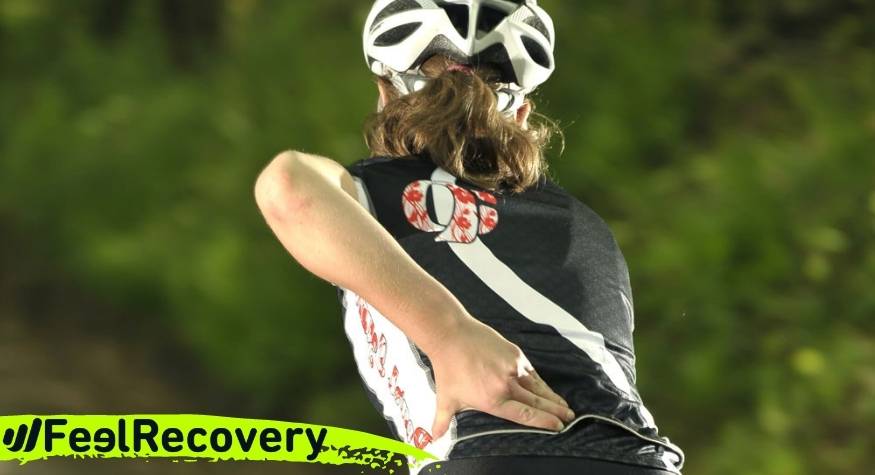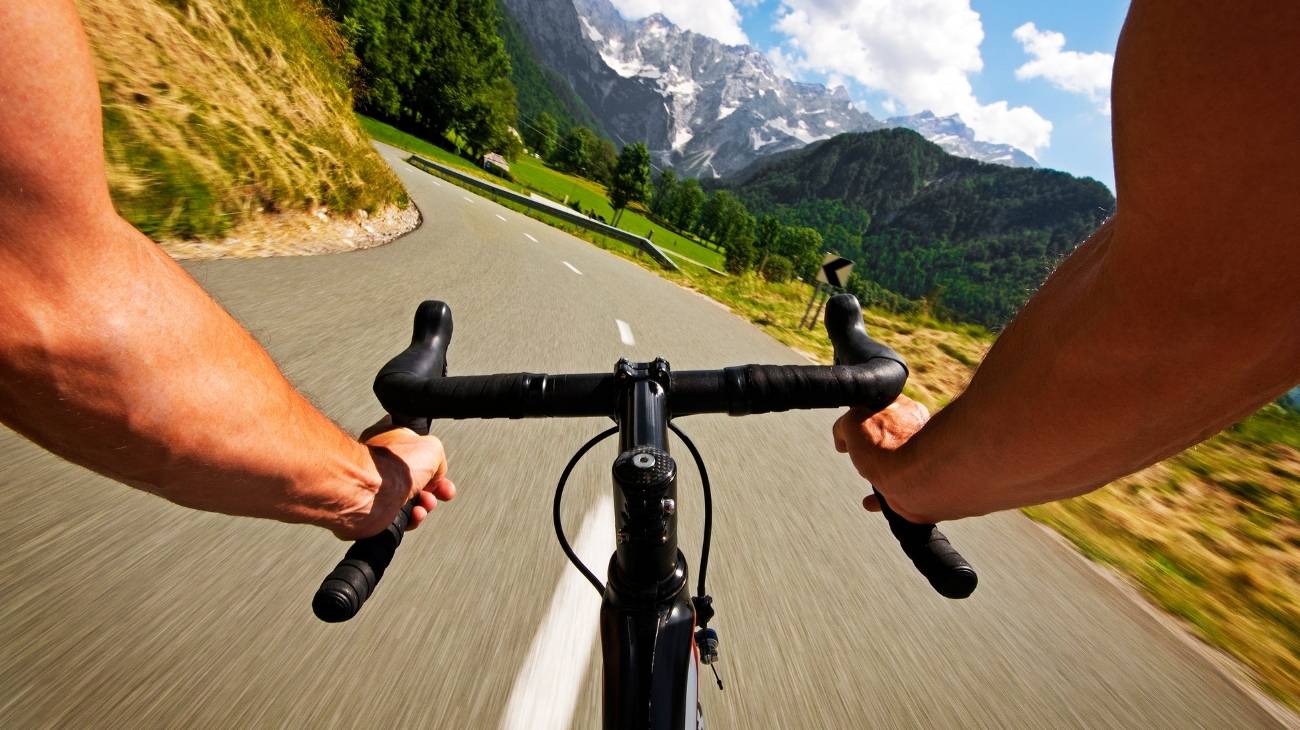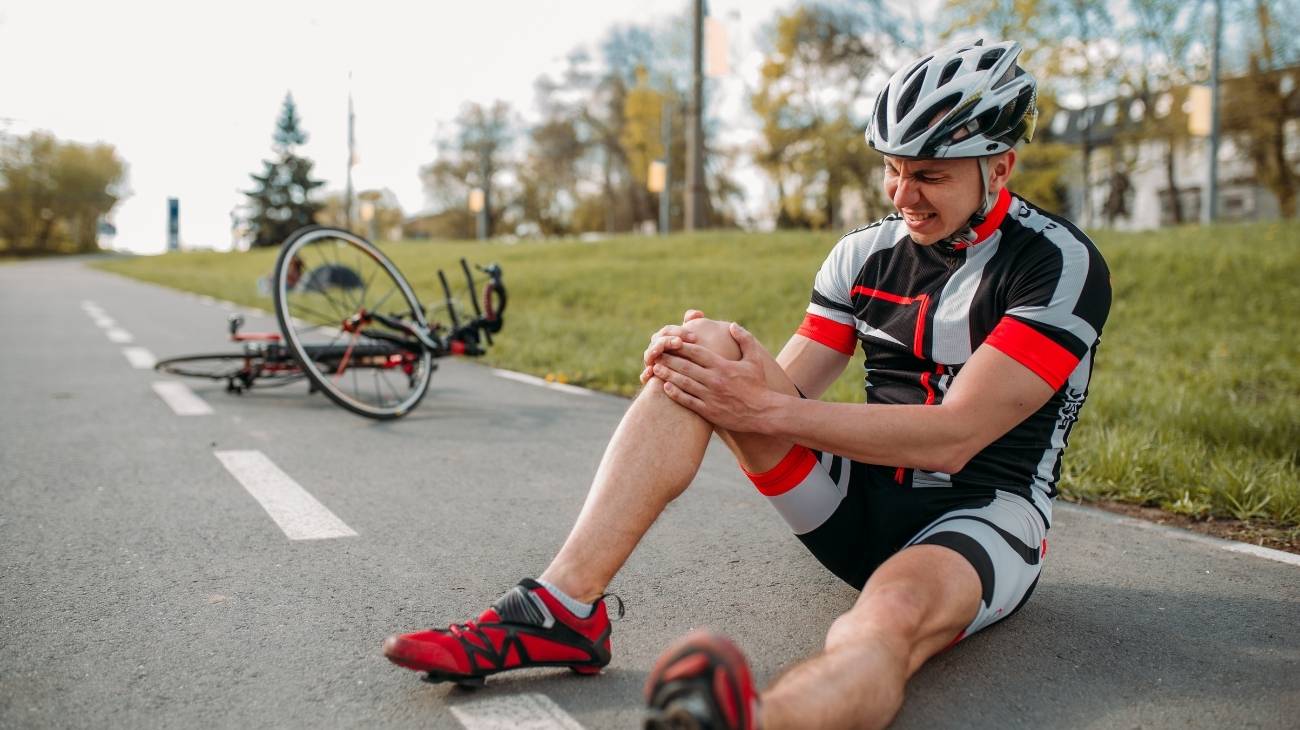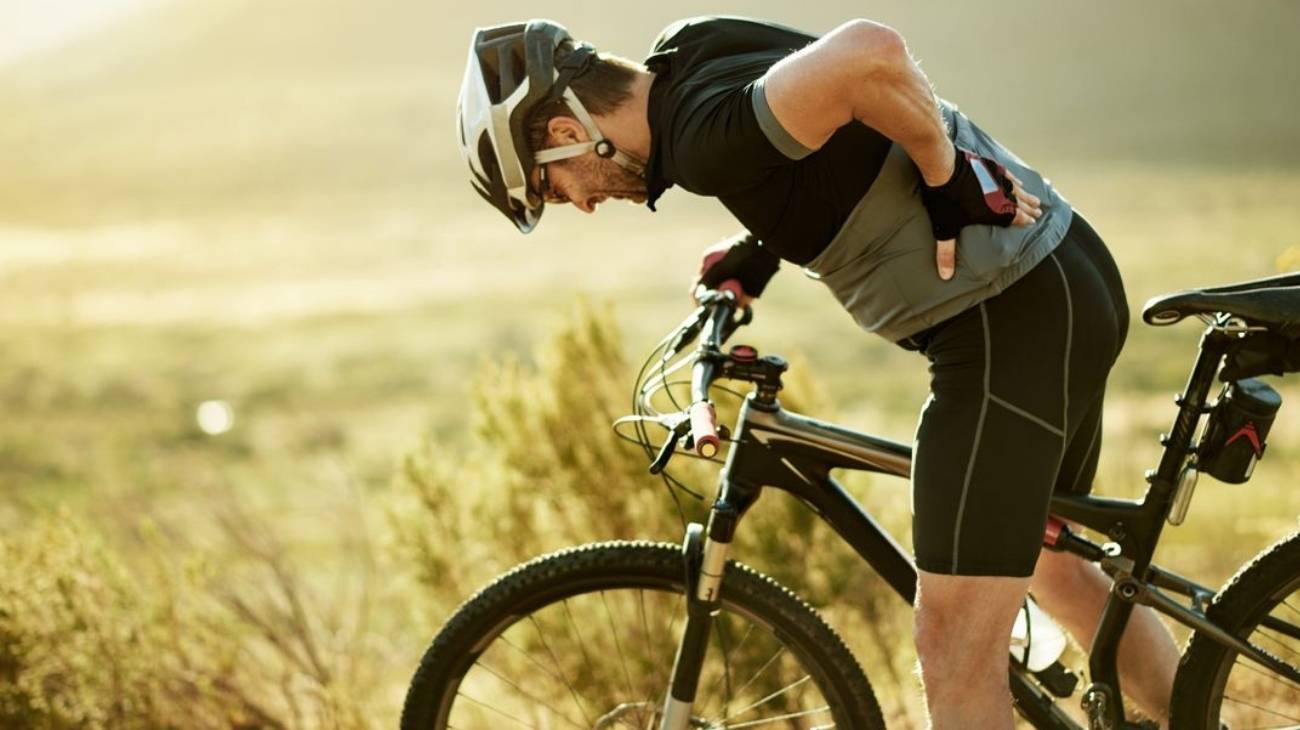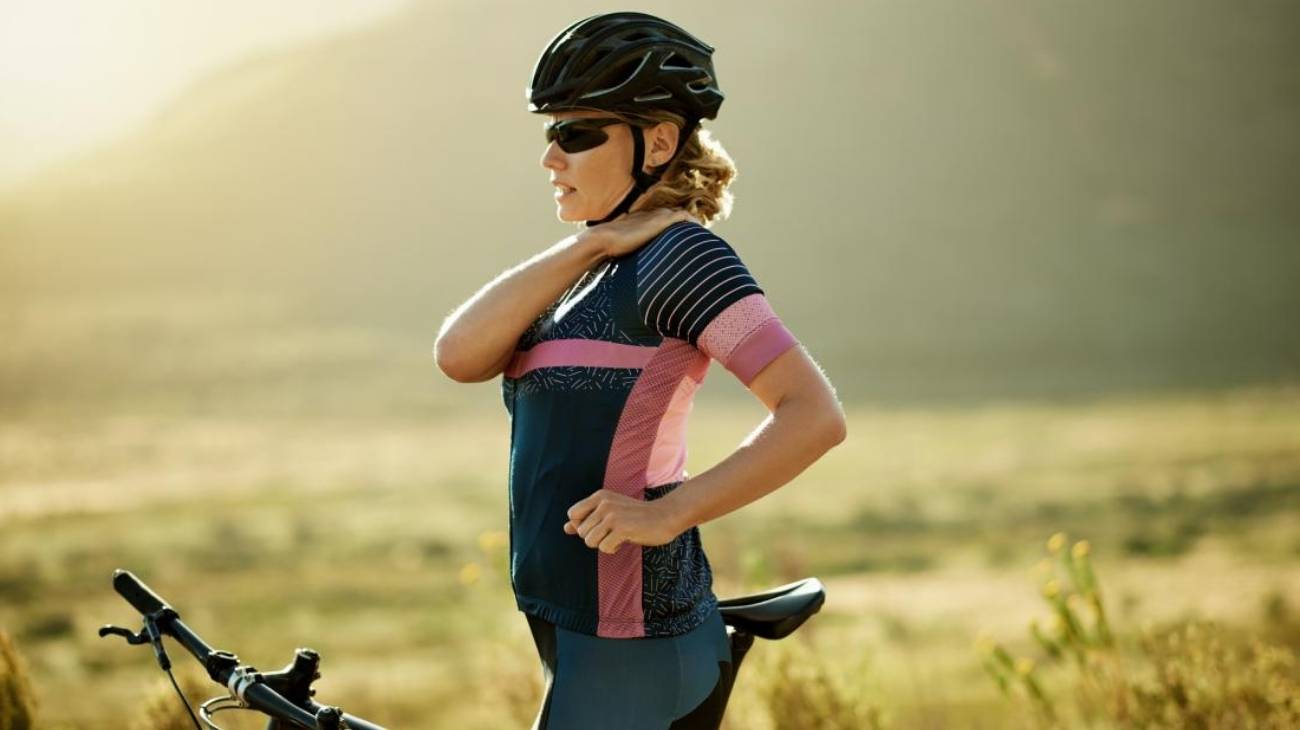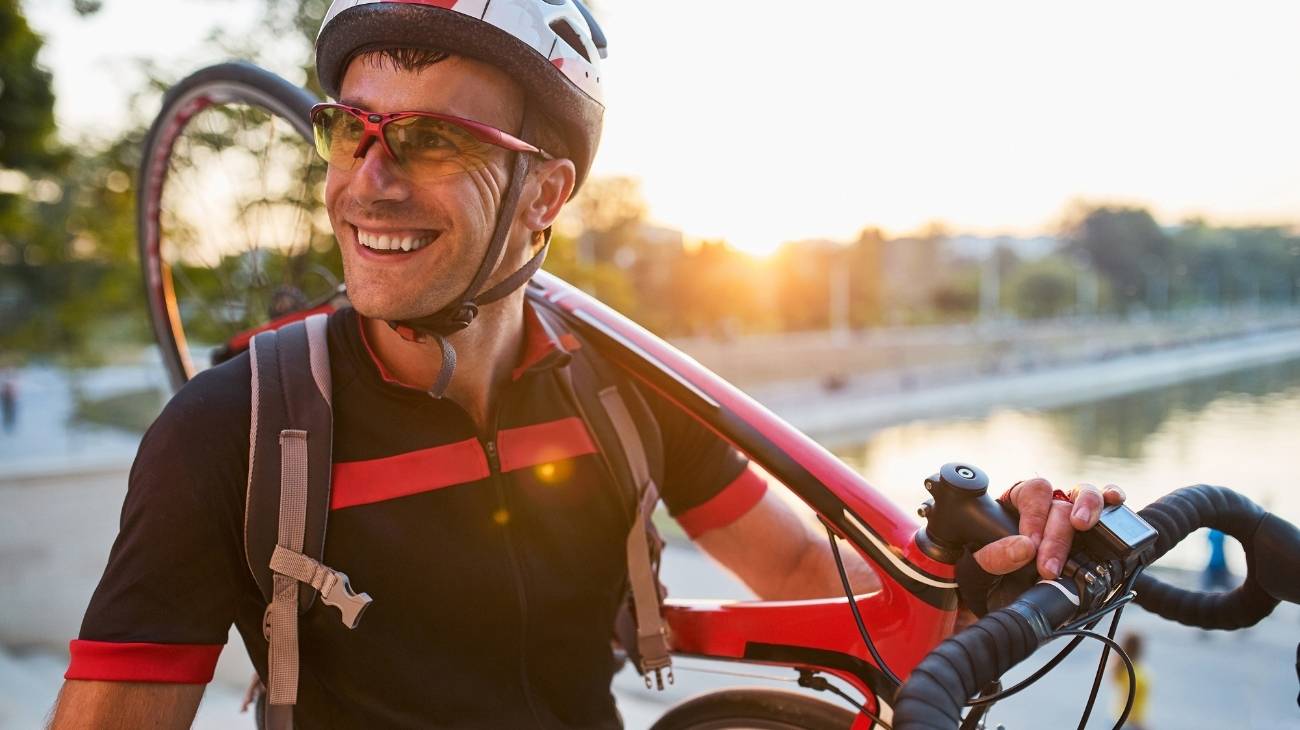Whether you are an amateur or a professional cyclist, you will always be exposed to back injuries. The main reason for this is poor body position and bad saddle and handlebar set-up.
By reading this article, you will clear up all your doubts about lower back and lumbar injuries in cycling. We will also show you how to apply the PRICE therapy to give first aid for a minor injury in these areas, and you will find out which are the best products on the market to aid recovery.
What are the most common types of lower back and lumbar injuries and pain in cyclists?
As not every bike is for every rider, it is common to find ailments related to poor body position in professional training and amateur practice. If the saddle is too high or too low, this is the root of all your back problems.
Check out the most common ailments below:
Muscle contractures
These are micro-tears in the muscle fibres after a great and repetitive effort, such as pedalling for hours on end in training or competition. When you return to a state of relaxation, the muscles are supposed to relax and everything goes back to calm, but in a contracture the muscle remains tense. The same happens when the origin is a bad posture of the cyclist.
If we allow these contractures to remain like this for a long time, without rest and without receiving physiotherapy treatment, they are likely to remain tense permanently and involuntarily, which is when full recovery becomes more difficult. What is the worst thing that can happen? The contracture can compromise a nerve in its motor or sensory function.
Lumbar overload
It is the accumulation of tension, uncontrollable and persistent in the muscles of the lower back. An overload in this area causes stiffness, pain and inflammation. Tension causes the muscles to compress and press on small vessels that supply blood to the muscle, thus impeding blood flow, which in turn leads to contracture. Causes range from poor body posture on the bike to a fall that causes a contusion.
Perineal injuries
Perhaps the name is unusual, but it is a real injury for a cyclist. Perineal injuries occur in isolation, but also in association with injuries to other pelvic, abdominal or lower limb organs. It is always a good idea to find out more about the real origin of your complaint. The discomfort is due to the support on the saddle for many hours at a time and continuous friction that can cause from skin injuries to damage to the abductors.
Muscle strain
Occurs when a muscle in the back is overextended or torn, which is a more compromising situation. It eventually leaves severe damage to the muscle fibres and pain that can only be relieved by applying the PRICE therapy you will learn in this article.
What causes a strain? Long periods of stress on the lumbar region caused by cycling for several hours, inadequate warm-up and poor natural flexibility. In cycling, it is normal for this to occur.
Low back pain
This injury is the inflammation or intense pain in the lower back, and can be caused by muscle overload in the area, or a sprained hip. In cycling, this injury is common after several hours on the bike for a long route in training, recreation or competition.
Lumbar osteoarthritis
This is an injury that appears after several years of cycling, although we can tell you from the outset that it is rare if you keep a correct practice of this sport. It occurs when the cartilage in the vertebrae of the lower spine degenerates, causing constant pain that comes and goes, as well as stiffness in the joint. While it can happen from years of maintaining a bad posture on the bike, there are also other factors to take into account such as chronic diseases like arthritis.
Best products for recovery from lower back and lumbar cycling injuries
Bestseller
-
Microwave Wheat Bag for Back Pain Relief (Extra Large) (Hearts)
£24,95 -
Microwave Wheat Bag for Back Pain Relief (Extra Large) (Oxford)
£24,95 -
Microwave Wheat Bag for Back Pain Relief (Extra Large) (Sport)
£24,95 -
Microwave Wheat Bag for Neck & Shoulder Pain Relief (Hearts)
£24,95 -
Microwave Wheat Bag for Neck & Shoulder Pain Relief (Oxford)
£24,95 -
Microwave Wheat Bag for Neck & Shoulder Pain Relief (Sport)
£24,95 -
Microwaveable Wheat Bag for Pain Relief (Hearts)
£20,95 -
Microwaveable Wheat Bag for Pain Relief (Oxford)
£20,95 -
Microwaveable Wheat Bag for Pain Relief (Sport)
£20,95 -
Wheat Bag for Microwave Classic Bottle Shaped (Hearts)
£20,95 -
Wheat Bag for Microwave Classic Bottle Shaped (Oxford)
£20,95 -
Wheat Bag for Microwave Classic Bottle Shaped (Sport)
£20,95
-
Back Support Belt (Black)
£39,95 -
Back Support Belt (Green)
£39,95 -
Back Support Belt (Pink)
£39,95 -
Ice Massage Roller Ball (Black)
£34,95 -
Ice Massage Roller Ball (Green)
£34,95 -
Ice Massage Roller Ball (Pink)
£34,95 -
Sacroiliac Support Belt (Black)
£24,95 -
Sacroiliac Support Belt (Green)
£24,95 -
Sacroiliac Support Belt (Pink)
£24,95 -
Soft Density Foam Roller for Recovery (Black)
£34,95 -
Soft Density Foam Roller for Recovery (Green)
£34,95 -
Soft Density Foam Roller for Recovery (Pink)
£34,95
How to apply the RICE therapy to treat lower back injuries in cycling?
This is a method recommended by physiotherapists and sports doctors, its approach is based on five key points and together they reduce inflammation and pain. The PRICE therapy is an update of RICE, as it was better known worldwide.
- Protection: In cycling it is best to have classic bandages and elastic bandages that allow you to quickly cover your lower back. The last thing you want is for the original complaint to become more complicated or for there to be new injuries linked to the first one.
- Rest: The length of the rest period will vary according to the type of injury, having the injured area inactive will favour recovery. In addition, during this phase, you should probably lie on your stomach to generate as little tension as possible in your back.
- Ice: If you notice pain or inflammation in the lumbar area, the application of ice can help to reduce the problem considerably. It should always be covered with plastic or a cloth so that it does not come into direct contact with the skin.
- Compression: Compressive garments can work well, and in this case a belt or girdle will be your best ally in treating a lumbar injury.
- Elevation: This involves raising the affected area above the level of the heart. You may think this is impossible in the case of the lower back, but all you have to do is lie on your stomach and put a pillow on your pelvis to keep the area elevated and achieve this goal.
References
- Marsden, M. (2010). Lower back pain in cyclists: A review of epidemiology, pathomechanics and risk factors. International SportMed Journal, 11(1), 216-225. https://journals.co.za/doi/abs/10.10520/EJC48389
- Clarsen, B., Krosshaug, T., & Bahr, R. (2010). Overuse injuries in professional road cyclists. The American journal of sports medicine, 38(12), 2494-2501. https://journals.sagepub.com/doi/abs/10.1177/0363546510376816
- Verrall, G., & Darcey, A. (2014). Lower back injuries in rowing national level compared to international level rowers. Asian journal of sports medicine, 5(4). https://www.ncbi.nlm.nih.gov/pmc/articles/PMC4335483/
- Manchikanti, L. (2000). Epidemiology of low back pain. Pain physician, 3(2), 167-192. https://www.painphysicianjournal.com/current/pdf?article=MzMx&journal=3
- Waddell, G. (2004). The back pain revolution. Elsevier Health Sciences. https://books.google.es/books?hl=en&lr=&id=MsM5EAAAQBAJ
- Kotler, D. H., Babu, A. N., & Robidoux, G. (2016). Prevention, evaluation, and rehabilitation of cycling-related injury. Current sports medicine reports, 15(3), 199-206. https://journals.lww.com/acsm-csmr/Fulltext/2016/05000/Prevention,_Evaluation,_and_Rehabilitation_of.18.aspx
- Aldred, R. (2016). Cycling near misses: Their frequency, impact, and prevention. Transportation Research Part A: Policy and Practice, 90, 69-83. https://www.sciencedirect.com/science/article/pii/S0965856416303639
- Kronisch, R. L. (1998). Mountain biking injuries: fitting treatment to the causes. The Physician and sportsmedicine, 26(3), 64-70. https://www.tandfonline.com/doi/abs/10.1080/00913847.1998.11440349
- Hollingworth, M. A., Harper, A. J., & Hamer, M. (2015). Risk factors for cycling accident related injury: The UK Cycling for Health Survey. Journal of Transport & Health, 2(2), 189-194. https://www.sciencedirect.com/science/article/abs/pii/S221414051500002X
- Embree, T. E., Romanow, N. T., Djerboua, M. S., Morgunov, N. J., Bourdeaux, J. J., & Hagel, B. E. (2016). Risk factors for bicycling injuries in children and adolescents: a systematic review. Pediatrics, 138(5). https://publications.aap.org/pediatrics/article-abstract/138/5/e20160282/60425/Risk-Factors-for-Bicycling-Injuries-in-Children

